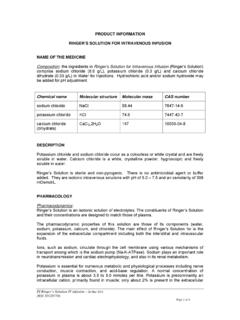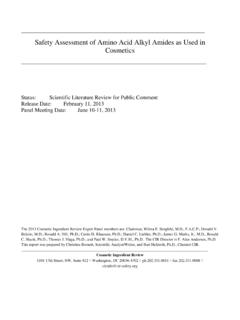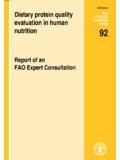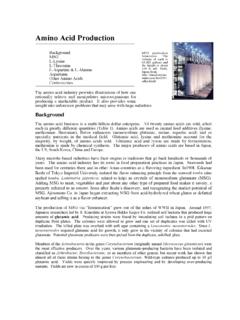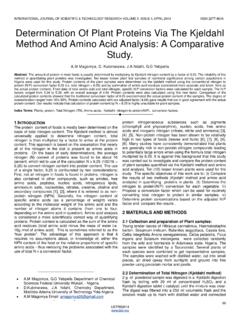Transcription of Name of the Medicine - Baxter Healthcare
1 PRIMENE Product Information name of the Medicine : Primene 10% ( amino acids Intravenous (IV) Infusion). Composition: Primene 10% amino acids IV infusion contains essential and nonessential L- amino acids. The composition and quantity of the L- amino acids in Primene 10% are shown in the following table. Table 1: each one litre of Primene 10% (w/v) contains Active constituents: Primene 10% (g). Lysine Glutamic acid Leucine Arginine Alanine Valine Isoleucine Aspartic acid Phenylalanine Glycine Serine Histidine Threonine Ornithine Monohydrochloride ( )*. Proline Methionine Tryptophan Cysteine Taurine Tyrosine Other constituents Malic acid to make pH Water for injection for 1000mL. Osmolality (mOsmol/kg) 840 (780). Note: under dilute conditions, osmolarity (mOsmol/L) is similar with osmolality (mOsmol/kg). The values in the brackets are osmolarity.
2 Those amino acids are L-isomer form; *) equivalent to ornithine base g. Description: Primene 10% amino acids IV infusion is a sterile, nonpyrogenic, hypertonic, clear, and colourless to slightly yellow solution of amino acids. It is intended for nutritional support in infants administered as an intravenous infusion. Primene 10% contains g/litre of amino acids, which supplies g/litre of nitrogen. It does not contain electrolytes. Primene 10% is a hypertonic solution having osmolality of 840 mOsmol/kg (10% solution). PRIMENE PI (ccsi43320151111) Page 1 of 16. Baxter PRIMENE Product Information Pharmacology: Actions: The composition of the amino acids formulated in Primene 10% amino acids IV infusion was designed to mimic that of amino acids in the umbilical cord of the last trimester of pregnancy. When Primene 10% is mixed with hypertonic glucose in a TPN admixture, it provides essential and nonessential amino acids for protein synthesis, while the glucose component provides energy.
3 It contains relatively low methionine and reduced amounts of phenylalanine and proline in order to match a limited capacity of the neonate's immature enzyme system. Primene 10% amino acids IV infusion solution also contains taurine. Taurine plays a role in the development and function of the brain and retina. The intracellular level of taurine is normally high in mature retina, muscle and in developing brain tissue. In neonates, the activity of cystathionase, the enzyme that converts methionine to cysteine, is low. Cysteine is a substrate for taurine synthesis. amino acids metabolism Ammonia is one of the deamination products of amino acids metabolism, that is, the amino group is converted to either ammonia or it is transferred via the enzyme aminotransferase to form another amino acid. Ammonia is metabolised to urea. The first step in the urea biosynthesis is the reaction of ammonia and carbon dioxide catalysed by carbamoyl phosphate synthetase (CPS) to form carbamoyl phosphate.
4 Then, carbamoyl phosphate enters the Krebs cycle urea synthesis. Pharmacokinetics: As the administration of Primene 10% is by intravenous route, bioavailability of the active ingredients is complete. No other data are available. Clinical trial: A five-day comparative study between Primene 10% and Vamin/glucose, designed as a double blind and randomised trial in neonates, using a total parenteral nutrition (TPN). admixture delivery system, was conducted at a single centre in London, UK. The TPN. solutions were infused by constant intravenous infusion over 24 hours through peripheral cannulae [N. McIntosh, V Mitchell, A clinical trial of two parenteral nutrition solutions in neonates , Arch. Dis Child, (1990), 65, 692 699]. The inclusion criteria were neonates who were unable to tolerate enteral feeds (oral feeding) and thus requiring TPN for at least five consecutive days in the first week of life.
5 Sixty-eight neonates were randomly allocated to either Primene 10% (n=34) or comparator IV infusion, amino acids 7% with glucose 10% (n=34) in a double blind fashion. Comparability of the groups was stratified to infants above and below 1000 g birth- weights. As premature infants they were critically ill, 41 were ventilated (85%) at the time of the entry to the study and 27 (52%) were still ventilated on the sixth day, the end of the trial. Forty-eight of the infants completed the five-day study protocol, Primene 10% group (n=23) and amino acids 7% with glucose 10% IV infusion group (n=25). Four infants died at the stage of allocation to this five-day first-week of life clinical trial. These deaths were PRIMENE PI (ccsi43320151111) Page 2 of 16. Baxter PRIMENE Product Information not related to either of the amino acids parenteral nutrition supplement compounded in the TPN admixtures.
6 These infants died due to their extreme prematurity and all had birth- weight of less than 1000 g. Death frequency for these critically ill patients were in accordance with the mortality rate of this type of patients treated at that hospital. The other 16 infants (eight in each group), who dropped out did not require the full five days parenteral amino acids infusion, thus, were excluded from the analysis. Efficacy was evaluated clinically on the basis of head circumference, and plasma amino acid levels. The body weight was also measured. Plasma amino acids levels and liver function tests were analysed on Days 1 and 5. When interpreting the results, it should be borne in mind that these infants were unstable, both from clinical and biochemical parameter perspectives. The body weight losses in both groups were similar, which were comparable to body weight decreases of infants borne at full term.
7 No significant differences were detected on the head circumference-decreases in both groups. On Day 5 of the trial, blood plasma of infants treated with Primene 10% (n=14) and those treated with amino acids 7% with glucose 10% IV infusion (n=16) were taken for assay of amino acid levels. Eighteen (9 in each group) were not assayed due to insufficient amount of plasma samples. The results are shown in Table 2. For a discussion on the other results, (see Adverse Reactions). Table 2: plasma aminograms (umol/L) on Day 5 in infants on Primene 10% and Vamin/glucose, according to birth weight, in comparison with range of values in cord blood from full terms infants. Birth weight Primene 10% Vamin Normal (kg) Range*. Leu <1 ( ) ( ) >1 ( ) ( ). IsoL <1 ( ) ( ) >1 ( ) ( ). Val <1 ( ) ( ) >1 ( ) ( ). Meth <1 ( ) ( ) >1 ( ) ( )a Cyst <1 ( )b ( ) >1 ( ) ( ).
8 Tau <1 ( )b 110 ( )b >1 ( ) ( ). Phe <1 ( ) (73)a >1 (33) ( )a Tyr <1 (100)a ( )a >1 ( ) ( )a Lys <1 ( )b ( )b >1 ( ) ( )b Thr <1 ( )b ( ) >1 ( ) ( ). PRIMENE PI (ccsi43320151111) Page 3 of 16. Baxter PRIMENE Product Information Birth weight Primene 10% Vamin Normal (kg) Range*. Hist <1 ( ) ( ) >1 119 ( ) ( ). Arg <1 ( )b ( ) >1 ( ) 49 ( ). Asp. Acid <1 ( ) ( )a >1 ( )a ( )a Ser <1 (36)b ( )a >1 197 ( ) ( )a Asn <1 ( )b ( )b (Asparagin). >1 ( ) ( ). Glu <1 ( )b ( ) >1 110 ( ) ( ). Gln <1 ( ) ( ) >1 ( ) ( ). Pro <1 ( ) ( )a >1 ( ) ( )a Gly <1 ( ) ( )a >1 ( ) ( )a Ala <1 ( )b ( ) 281-595. >1 (176) (228). Cit <1 ( ) ( ) >1 ( ) ( ). Orn <1 80 ( ) ( ) >1 ( ) 98 (75). Notes : Birth weight < 1kg # = 5; > 1kg # = 9 on Primene 10%. Birth weight < 1kg # = 8; > 1kg # = 8 on Vamin/glucose a = above normal range; b = below normal range;. *) = Rigo J.
9 Thesis University of Liege, Belgium (1980). see, , V. Mitchell, A clinical trial of two parenteral nutrition solutions in neonates , Arch. Dis. Child., (1990), 65, 695). Indications: Primene 10% amino acids IV infusion is indicated in infants and neonates at term or premature for short-term use, of normal or low birth-weight when oral or enteral nutrition is impossible, insufficient or contraindicated. It is used as an amino acid component in a composite admixture of total parenteral nutrition. Contraindications: Primene 10% amino acids IV infusion is contraindicated in children with a congenital abnormality in the metabolism of one or more amino acids, irreversible hepatic damage, untreated uraemia, or known hypersensitivity to any of the active substances or excipients , or to components of the container. PRIMENE PI (ccsi43320151111) Page 4 of 16.
10 Baxter PRIMENE Product Information Precautions: General Administrations of Primene 10% amino acids IV infusions require knowledge of fluid- electrolyte balance and nutrition as well as clinical expertise in recognition and treatment of the complications, which may occur. Frequent clinical evaluation and laboratory determinations are necessary during the treatment with Primene 10% amino acids IV. infusion. Monitoring should be appropriate to the patient's clinical situation and condition, and should include determinations of water and electrolyte balance, acid/base balance, blood and urine dextrose, serum proteins, kidney and liver function tests, serum and urine osmolarity, and the level of ammonia in the plasma. It is essential to provide adequate energy from other sources concurrently if the amino acids administered parenterally are to be retained by the body and utilised for protein synthesis.
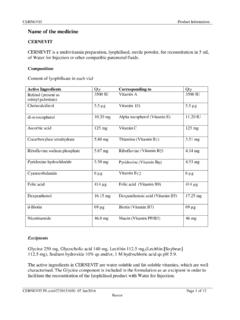
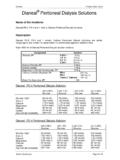
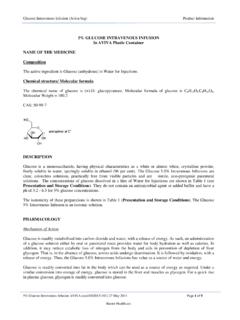
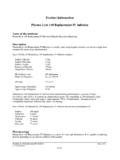
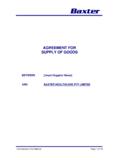
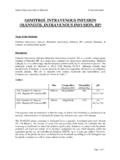
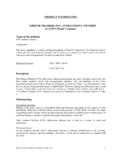
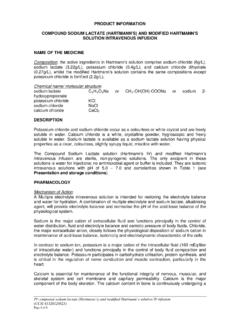
![T I S S E E L [Fibrin Sealant] - Baxter Healthcare](/cache/preview/5/e/c/8/3/b/b/2/thumb-5ec83bb2d349410260af6c556ae67fe3.jpg)
